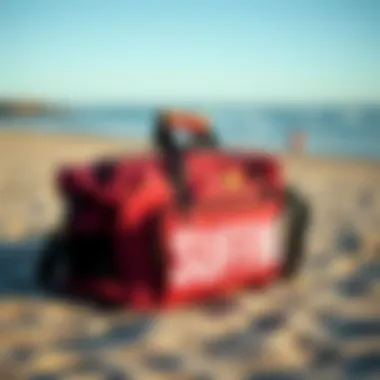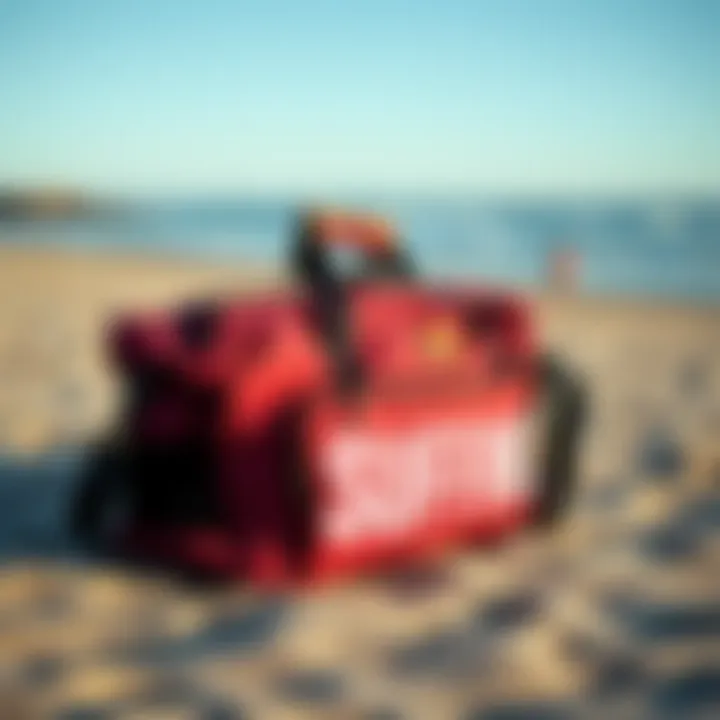Key Considerations for Selecting Surfing Travel Bags


Intro
When it comes to chasing waves and seeking that perfect surf experience, having the right travel bag can make a world of difference. Surfing travel bags not only serve as vessels to carry your cherished gear but also play a critical role in preserving your equipment, ensuring everything remains in tip-top shape, especially while jet-setting off to the next adventure. In this guide, we’ll explore the must-know elements of surfing travel bags—discussing their types, materials, design considerations, and packing secrets that cater specifically to the needs of kiteboarders.
With kiteboarding becoming increasingly popular among adventurous spirits, understanding what makes a quality travel bag can’t be overlooked. Let’s lay the groundwork for what is to come by examining some key points that will be discussed in this article.
Gear Insights
Latest Gear Reviews
Staying in tune with the latest offerings in the market can spark a real excitement within any kiteboarding aficionado. Here, we’ll dive into a few top contenders that have made waves in the surfing travel bag scene:
- ProLite Wheeled Surfboard Bag: This bag is a game-changer with its spacious interior and durable wheels, making it easier to navigate busy airports while keeping your board safe.
- Dakine ROLLING TRAVEL BAG: Designed for the avid traveler, this bag boasts enough space for multiple boards and comes equipped with padded compartments. It’s like a fortress for your beloved gear.
- FCS Premium Shortboard Travel Bag: For those who prefer simplicity without skimping on protection, this travel bag provides great insulation and storage options; think of it as a cozy blanket for your surfboard.
Each of these bags, with their unique features, showcases the importance of investing in quality gear that meets diverse travel needs.
Essential Gear for Beginners
For those just starting with kiteboarding or surfing, selecting the right travel bag can feel like navigating choppy waters. Here are some essentials to consider:
- Size and Capacity: Make sure your travel bag can accommodate your gear. Look for bags that are spacious, yet easy to carry.
- Padded Protection: A bag with ample padding helps shield your board from bumps during transit.
- Weather Resistance: A waterproof material ensures your gear stays dry, especially when facing unexpected weather shifts.
- Lightweight Design: Hauling around a heavy bag can quickly become laborious. Opt for lightweight options that don’t compromise on durability.
By choosing the right bag from the start, beginners can enhance their travel experience and protect their equipment from potential damage.
“Investing in a quality travel bag is akin to giving your gear a sturdy insurance policy.”
As we progress through this article, we will further dissect materials, design features, and valuable packing tips tailored for kiteboarders to ensure that every trip—whether a weekend getaway or a grand surf expedition—is smooth and enjoyable.
Prelude to Surfing Travel Bags
Surfing travel bags are not just mere accessories; they're essential companions that safeguard your prized gear while you embark on the journey of catching waves. For kiteboarding enthusiasts, having the right bag is crucial. It’s about ensuring that your equipment is well-protected and that your travel experience is smooth and hassle-free. As you navigate through bustling airports or navigate the winding roads to remote beaches, a durable and thoughtfully designed travel bag makes a world of difference.
Significance of Travel Bags in Surfing
When you think about the significance of travel bags in surfing, consider this: they act like the front line for protection against the elements. Surfboards and related gear are typically expensive and delicate. Finding ways to keep them safe while traveling is paramount. Whether it's the bumps and scrapes of airline baggage handlers or the saltwater spray from windy coastal drives, a quality bag can mean all the difference between equipment that survives the journey unscathed and gear that suffers serious damage.
A travel bag tailored for surfing can help you avoid unnecessary costs and stress. These bags often come with extra padding, making a stronger defense against impact. They also provide convenience, allowing you to neatly pack multiple items, such as wetsuits and fins, alongside your board without forgetting anything essential. The significance of travel bags cannot be overstated; they are the guardians of your gear that ensure you're ready when the waves call.
Overview of Key Features
Not all travel bags are created equal. Understanding the key features that make some bags stand out from the crowd can be a game changer.
- Padding and Protection: Look for bags with thick padding, which absorbs shocks. This is critical, especially when flying or traveling by bus.
- Water Resistance: A water-resistant material keeps your gear dry and safe from unexpected rain showers. This is particularly vital for kiteboarders, as wet gear can lead to mold or deterioration.
- Storage Compartments: More compartments mean better organization. Find a bag that can house your board, wetsuits, and miscellaneous gear efficiently.
- Sturdy Straps and Handles: Comfortable straps can greatly enhance your travel experience. You'll appreciate a good strap when lugging your gear around crowded places.
Incorporating these features into your choice not only ensures the longevity of your gear but also enhances your overall travel experience. Keep your eyes peeled for innovation; the right bag might just have that extra pocket or durable construction that sets it apart.
"Investing in a quality travel bag is like putting a solid lock on your gear; it might cost a bit upfront but saves you a world of trouble down the line."
Choosing the right travel bag can simplify your adventures and protect your equipment, allowing you to focus on what matters most: hitting the waves with confidence.
Types of Surfing Travel Bags
When it comes to prepping for a surf trip, the type of travel bag can make or break your adventure. Selecting the right surf bag is fundamental. Whether you’re a seasoned surfer or just getting your feet wet, knowing the options available ensures that your gear remains intact and your travel ease isn’t compromised. From practical considerations to personal preferences, this section sheds light on four key types: board bags, day bags, wheeled bags, and a comparison of backpacks versus duffle bags. Each serves a unique purpose and comes with its own set of advantages and considerations.
Board Bags
Board bags are often the unsung heroes of surf travel. Designed specifically to protect your surfboard during transit, they come in varying sizes for different board types. The primary advantage of these bags is their padding, which helps absorb shock during handling or transport. A great choice for traveling to destinations with unpredictable baggage handlers.
Along with protection, these bags often include additional features like fin compartments and even backpack straps for ease of transport. However, keep in mind that they can be cumbersome, especially when you’re navigating through crowded airports or harsh terrains. Pick a board bag that fits snugly, but offers enough room for some padding around your board. If not, you might end up with a crushed nose or tail after your long journey.
Day Bags
If you’re hitting the beach for a quick session and don’t need to carry as much, day bags emerge as a practical solution. Typically lighter and more compact than board bags, these are ideal for local outings or short trips. They provide basic protection against dings and scratches, which is more than enough for a day of riding waves.
The downside? They can lack adequate padding for heavier impact situations, so they’re not the best fit for air travel. Also, the lack of storage compartments can make organization a bit tricky. Still, the simplicity and light weight make day bags a popular choice among many surfers looking to keep their gear light and their focus on the waves.
Wheeled Bags
For the avid traveler, wheeled bags blend the best of both worlds—capacity and convenience. These bags are designed for heavy loads and long-haul trips, providing ample room to store multiple boards and other essential gear. The wheels make navigating through aisles, terminals, and over uneven surfaces far easier, reducing the stress on your back and shoulders.
However, the trade-off is usually weight; wheeled bags can be heavier than their non-wheeled counterparts. Moreover, be mindful of the added size; you may need to fork out some extra cash for excess baggage fees. That said, if you’ve got multiple boards to carry and plan a longer stay, wheeled bags might just be your best bet.


Backpacks Versus Duffle Bags
The choice between backpacks and duffle bags essentially boils down to personal preference and the specifics of your surf trip. Backpacks are generally ergonomically designed for comfort, making them easy to carry on your back while you navigate to the waves. Many come with special compartments for wet gear, which is a blessing after a long day on the water.
On the flip side, duffle bags often offer more storage space and easier access. They tend to open wide, making it easy to stuff and retrieve your gear. However, they can be a bit bulky to carry, especially when full. When deciding between these two, consider your transport mode and the duration of your trip.
"Investing in the right travel bag is as crucial as the surfboard itself; each piece plays a role in ensuring an enjoyable and hassle-free experience."
In summary, selecting the appropriate type of surfing travel bag not only enhances your travel experience but also protects your valuable gear. Choose wisely based on your needs and comfort level to maximize both functionality and enjoyment. Understanding the differences among board bags, day bags, wheeled bags, and the nuances of backpacks versus duffle bags will empower you to make an informed choice that suits every surf adventure.
Material Considerations
When it comes to selecting a surfing travel bag, the materials used in its construction are paramount. Not only do they influence the longevity of the bag, but they also dictate how well it protects your precious gear during your adventures. Let’s dive into the specifics of material considerations, and why they matter so much to kiteboarders and surfers alike.
Durability and Weight
A surf travel bag must strike a balance between being light and tough. Heavy bags can become burdensome when making long treks to your favorite spot, while bags made from flimsy materials won’t withstand the rigors of travel. A good quality bag typically features materials like 600D polyester, which is heavy-duty yet light enough to carry without feeling like you’re hauling boulders.
The trade-off between durability and weight can be crucial. For example, a bag made from reinforced nylon might be great for an enduring road trip, but you’d want something less bulky and easier to handle for air travel. A bag that is built like a tank, yet weighs just a few pounds, is the goal you should aim for.
"Choosing a well-made surfing travel bag is like picking a reliable partner; you want something that can carry your burdens without adding to them."
Water Resistance
Surfers know that water and gear don't always mix well, making water resistance a vital feature. A bag that’s not water-resistant can lead to soggy wetsuits and ruined equipment. Materials treated with waterproof coatings or those with a natural resistance, like polyurethane, are often the go-to choices for safeguarding against unexpected splashes.
Moreover, consider the stitching and zippers. Even if the main fabric is durable, if the seams are not properly sealed, water can seep through. So browse for bags that boast adequate seam sealing. Some advanced models come with water-repellent zippers as well. If you frequently find yourself in rainy climates or are crossing streams while hiking to your next surfing locale, you would want a bag built to take the wet without a fuss.
Eco-Friendly Options
Sustainability is becoming increasingly important among travelers, and the surf community is no exception. Many brands are beginning to recognize the need for eco-friendly materials that don’t compromise on performance. Options made from recycled plastics, organic cotton, or bio-based materials are starting to surface in the market.
Using eco-friendly bags not only reduces waste but also sends a signal that as surfers and kiteboarders, we care about the oceans and the environment we play in. For instance, brands like Patagonia and O’Neill have been leading the charge by creating bags that are not only functional but also made with sustainable practices. Opting for these can represent a stride towards better environmental stewardship while still aiming for durability and utility.
When you choose materials keenly, you not only select a bag that fits your needs but also contribute positively to the global ecosystem. Ultimately, you’ll want your travel bag to be a reflection of your values, making careful material consideration essential.
Functional Design Features
When it comes to choosing a surfing travel bag, the functional design features are nothing short of paramount. These elements play a pivotal role not only in how you transport your gear but also in ensuring it remains safe and accessible during your travels. With the right design, a travel bag can elevate your overall surfing experience, making it less about worrying over equipment and more about enjoying the waves.
Padding and Protection
One of the most crucial aspects of surf travel bags is padding and protection. A bag without adequate padding is like a lifejacket with holes; you're just asking for trouble. Heavy-duty foam padding acts as a cushion, absorbing shocks that occur during transport—particularly when checking bags at the airport or tossing them into the back of a vehicle. In many cases, the thickness of the padding might vary even within the same model. You should keep an eye out for areas that require extra protection, such as the nose and tail of the board.
Also, materials matter. Look for bags made with high denier fabrics that resist tearing. For example, the Armada Travel Bag features reinforced corners that ensure prolonged durability. Remember, a little extra investment in protection could save your prized board from catastrophic damages.
Storage Compartments
Storage compartments add another layer of utility to surf travel bags. Think of them as the bag's control center—everything has its place. Compartmentalization allows you to organize gear, from wetsuits and leashes to surf wax and fins. Imagine packing all your bits and pieces in a chaotic jumble only to realize you've forgotten something essential. With a well-designed bag, your equipment will always be just a zip away.
Look for bags with dedicated pockets: a separate wet/dry section can be a lifesaver after a long day in the waves. Certain brands even incorporate external pockets for quick access to items like sunscreen or sunglasses, keeping those essentials out of the main compartment. This is invaluable when you're on the move, ensuring you have what you need without rifling through your entire bag.
Strap Design
Lastly, let’s not overlook strap design—a feature often eclipsed by flashier attributes but equally vital. The quality and layout of straps can significantly influence your comfort and ease of travel. A shoulder strap that digs into your skin over time can make even the most exciting trip feel like a chore. Seek out bags with adjustable, padded straps to help distribute weight evenly.
Also, consider options that come with multiple carrying configurations—like dual straps or trolley sleeves. Whether you’re lugging your gear through crowded airports or trekking to a secluded beach, ensuring your bag is easy to carry can make all the difference when fatigue sets in. Trust me, putting thought into strap design can turn a burdensome load into a manageable one.
A well-designed travel bag makes the journey smoother, allowing you to focus on what truly counts—the waves.
In summary, functional design features— including padding and protection, storage compartments, and strap design—are integral for any surfing travel bag. They add value beyond a simple transport device, providing a thoughtful organization and safeguarding your investments in surfing gear, helping both novice and seasoned surfers make the most of their journeys.
Traveling with Surfing Gear
The act of traveling with surfing gear is not just about shoving your board into a bag and hopping on a plane or into a car. It involves thoughtful planning and careful consideration, especially when you aim to preserve the integrity of your equipment while optimizing the convenience of your journey. When you're heading to catch those perfect waves—whether it’s a weekend surf trip down the coast or an expedition halfway around the globe—understanding the nuances of transporting your gear can make all the difference. Factors such as safety, accessibility, and practicality are paramount, as they ultimately shape your surfing experience and ensure you hit the waves without a hitch.
Air Travel Considerations
Flying with surfboards introduces a unique set of challenges. Airlines often have stringent policies regarding oversized baggage, and your prized surfboard is typically classified as such. It's essential to take a peek at your airline’s baggage policy before packing. Some may charge hefty fees for transporting boards, while others might limit their size or weight. Moreover, investing in a quality board bag with ample padding is imperative to shield your board from dings and damage during handling.
Airports can be chaotic, and navigating through crowds while hauling a surfboard can be a true test of patience. Consider traveling during off-peak hours or arriving early to alleviate some of that stress. Don’t forget to utilize your board bag’s compartments effectively. Storing smaller items, like wax or fins, in the same bag can save room in your carry-on and keep essentials on hand.
Driving and Road Trips


Road trips present a different dynamic altogether. You have the luxury of flexibility; however, that doesn’t mean you can throw caution to the wind. Before hitting the road, ensure your gear is securely fastened, as loose items can easily become projectiles during sudden stops. Invest in a good board rack for your vehicle if you frequently travel by car. This not only simplifies the loading process but also keeps your cargo safe and sound.
When mapping out your route, keep an eye out for drive-throughs or stops that may not accommodate surf-related gear easily. It might seem trivial, but planning ahead can save you the headache of building unnecessary detours. And, while you’re on the road, utilize any downtime to inspect your gear; a small crack today may escalate into a bigger issue tomorrow.
Public Transport Options
For those who prefer public transport, bringing your surfing gear can feel likemy a juggling act. Trains, buses, or subways often come with restrictions on bag size, which can transform your pre-surf excitement into a logistical maze. One strategy is to look for destinations that offer bike racks or cargo spaces specifically designed for sports equipment. This increases your odds of fitting your surfboard, whether you’re heading to the beach or a surf spot off the beaten path.
With this mode of travel, simplicity is your friend. A compact board bag and a lightweight backpack can streamline your journey and make navigating crowded stations less daunting. Always be prepared for a bit of a workout; whether it’s lifting your gear onto a train or running to catch the next bus, being physically ready will pay off. Familiarize yourself with local transport rules and plan your travel times to avoid rush hour. The right approach to public transport can open up a world of surfable locations without the logistical stress.
"Each mode of transport offers unique pros and cons; understanding them can unlock incredible surfing adventures."
Packing Techniques
Packing techniques play a pivotal role when it comes to traveling with surfing gear. Ensuring that your equipment survives the journey unscathed is more than a mere matter of convenience; it's about preserving your investment and ensuring a seamless experience once you hit the waves. A methodical approach to packing can also help you maximize your space and make everything accessible when you need it. Let's delve into some essential techniques to keep your gear safe and sound.
Maximizing Space
When it comes to packing your surfing gear, space is a premium. Efficient use of space can save you from hefty baggage fees and make handling your bag much easier. Here are some strategies:
- Roll Your Clothes: Instead of folding, rolling your clothes minimizes wrinkles and saves space. Think of it this way: a snug roll can fit into nooks and crannies you might have overlooked when stacking items flat.
- Utilize Every Compartment: Take full advantage of your bag's storage compartments. Stuff smaller items like wax and sunscreen into gaps before zipping everything up.
- Layer Strategically: Place heavier items like wetsuits or tools at the bottom for stability, and consider lighter materials on top. This not only maximizes space but also maintains balance while you carry the bag.
By employing these strategies, you can significantly increase your packing efficiency while ensuring that all essential items are easily accessible when needed.
Protecting Fragile Gear
The well-being of your gear hinges on how well it is protected during transit. Surfboards, fins, and other accessories can be delicate, thus needing special attention:
- Use Padding: Invest in quality bag padding. Well-padded bags can absorb shocks and prevent dings from occurring during transit. In case your bag accidentally gets dropped, you'd be grateful for those extra inches of foam protection.
- Separate Gear: If you're traveling with multiple boards, use dividers or even old towels to keep them apart. This will help prevent scratches and irreparable damage.
- Harness the Power of Bubble Wrap: For that extra layer of protection, consider wrapping fragile or valuable items in bubble wrap before stowing them in your bag. You’ll appreciate the peace of mind this brings when getting through airport security.
Implementing these protective measures can greatly enhance the lifespan of your gear.
Weight Distribution for Balance
Heavy lifting is part of traveling with surfing gear, so proper weight distribution is key to avoiding backaches and ensuring the comfort of carrying your bag:
- Evenly Distribute Weight: Arrange heavier items throughout your bag rather than concentrating them in one area. This aids in creating a balanced feel, making the bag easier to carry.
- Position for Comfort: Place heavier items towards the bottom of your bag. This not only stabilizes it while moving but also reduces strain on your back and shoulders.
It's a recipe for disaster when you throw gear haphazardly into your bag, so take a moment to plan out your packing methodically. Proper packing techniques will rejuvenate your travel experience, giving you one less thing to stress about as you venture out to catch those elusive waves.
Always remember that a well-packed bag is not just about fitting everything in; it's about fitting everything in well.
For more informative insights on gear preservation, check out Wikipedia or Britannica.
These techniques will not only protect your gear and maximize space, but will also help set you up for successful surf trips ahead.
Maintenance of Surfing Travel Bags
Maintaining surfing travel bags is crucial for preserving not only the bag itself but also the expensive gear that is packed inside. With the wear and tear that bags endure during travel, a few simple maintenance practices can extend their lifespan significantly. Ensuring that your travel bags are in optimal condition means enhanced protection for your surfboards and accessories, ultimately contributing to a more enjoyable surfing experience.
Cleaning Recommendations
To keep your surfing travel bag in good shape, regular cleaning is a necessity. Saltwater, sand, and dirt can accumulate quickly and compromise the integrity of the materials. Here's how to properly clean your bag:
- Rinse Immediately: After every trip to the beach or a surf session, rinse your bag with fresh water to remove salt and sand. It's better to do this before the debris has a chance to dry and stick.
- Gentle Soaping: Use a mild detergent mixed with warm water. A soft cloth or sponge works wonders when wiping down the exterior and interior surfaces. Avoid harsh chemicals that could damage the materials.
- Air Dry: After washing, leave your bag open in a well-ventilated space. Avoid direct sunlight for long periods to prevent the fabric from fading or becoming brittle.
Using these simple steps ensures your travel bag stays clean and prolongs its life and utility.
Repairing Common Damages
Inevitably, some wear and tear may occur, no matter how careful you are. Learning how to make basic repairs can save you time and money in the long run. Here are common damages and their repair methods:
- Zipper Issues: A zipper that refuses to budge can often be fixed with a little lubricant or by carefully realigning the tracks. In extreme cases, consider replacing the zipper; many craft stores sell zippers in different lengths.
- Fabric Tears: Patches are a quick way to handle small tears. For larger rips, sewing a new piece of fabric over the area may be necessary. Use a needle and durable thread for a secure hold.
- Strap Repairs: If a strap tears or comes loose, sewing it back in place is a good option. Use heavy-duty webbing for replacements; it will hold up better than standard fabric.
Having the right tools handy to address these damages can make a substantial difference in how long your bag lasts.
Storage Tips When Not in Use
Storing your surfing travel bag correctly can prevent unnecessary damage while it sits idle. Here are some guidelines to follow:
- Clean Before Storing: Always clean your bag thoroughly to prevent mildew and odors. Ensure it is completely dry before placing it in storage.
- Choose the Right Location: Keep the bag in a cool, dry place away from direct sunlight and extreme temperatures. A closet or a storage container can serve as an ideal location.
- Avoid Overloading: If you’re placing items inside the bag for storage, avoid overpacking it. Lightly packing can help maintain the shape and prevent undue stress on the seams and material.


By following these storage tips, you’ll ensure your surfing travel bag remains in peak condition, ready for your next adventure.
Proper maintenance is not just about cleaning; it’s about ensuring your gear is protected, allowing you to focus on what truly matters—enjoying your time on the waves.
Maintaining your surfing travel bag may seem like a chore, but the benefits far outweigh the effort involved. Regular upkeep will secure your investment, make your travels smoother, and ensure peace of mind so you can hit the waves without worry.
Buying Considerations
When it comes to selecting a surfing travel bag, the stakes are pretty high. Not only is the functionality of the bag essential, but so is its ability to protect your gear while you’re out and about. Understanding the nuances of buying considerations is crucial, especially for kiteboarders and surfers who frequently venture to new spots. Here, we delve into three fundamental aspects that should shape your buying journey: researching brands and models, budgeting for quality, and reading consumer reviews.
Researching Brands and Models
The surfing travel bag market is a jungle, teeming with various brands and models, each boasting unique features. It's tempting to grab the first bag that catches your eye, but doing a little homework pays off in the long run. Start by narrowing your focus on the brands that are renowned for their craftsmanship and customer service.
Some notable brands like Dakine, FCS, and Pro-Lite consistently deliver quality. Explore their offerings and compare features. Look for materials, padding, and durability that set them apart. Brands often have their own set of loyal enthusiasts, so forums and discussion groups like Reddit can provide useful insights.
Additionally, consider the specific models that cater to your style. Some bags are designed for short trips while others cater to those who travel extensively. Check their specs – you want a balance between lightweight convenience and rugged functionality.
Budgeting for Quality
You might think that ideally, you can get a decent bag for a bargain. However, if you’ve ever had a travel bag unravel at the seams just before a big trip, you know that you get what you pay for. Investing in a quality bag can save you both heartache and money down the line. While it’s not necessary to break the bank, setting a reasonable budget and sticking to it while prioritizing quality can make all the difference.
Typically, lightweight backpack-style bags are on the lower end, while wheeled options or heavily padded board bags can cost considerably more. Aim for bags that provide a good warranty as well; many premium products come backed by solid guarantees, which reflects the manufacturer’s confidence. A well-made bag is less likely to need replacements or repairs.
Reading Consumer Reviews
Before making that final purchasing decision, consumer reviews serve as a goldmine of information. Dive into platforms like Amazon, Facebook, or dedicated surf forums to gain insights about real-life experiences with the bags on your shortlist. Look for feedback on comfort, durability, and overall practical usability.
While star ratings give a quick snapshot, the written reviews tell the actual story. Pay attention to comments regarding travel experiences, particularly how the bags held up during air travel or road trips. Was there sufficient padding? How did the zippers fare?
Reading user experiences is not just about ensuring satisfaction; it also informs you about potential pitfalls and benefits that you might not have considered. This will greatly help you avoid common mistakes and make an informed selection.
"A thoughtful investment in the right travel bag is like insurance for your surfing gear; it pays off big time when the unexpected arises."
In summary, buying considerations for surfing travel bags hinge on thorough research, mindful budgeting, and leveraging consumer testimonials. When you get these factors right, you’ll not only ensure the safety of your gear but also enhance your traveling experience. Armed with this understanding, you’ll be well-equipped to navigate the vast landscape of surfing travel bags.
Case Studies: Popular Brands
In the vast world of surfing travel bags, brands play a pivotal role in dictating quality, performance, and reliability. Understanding the varying offerings from different manufacturers provides significant insights for enthusiasts seeking a dependable travel companion for their gear. By examining established players in the industry, one can grasp both the strengths and weaknesses of each, enabling informed choices. This section invites readers to journey into the realm of popular brands, comparing their products and uncovering user experiences.
Brand Comparisons
When it comes to selecting a surfing travel bag, not all brands are created equal. A few heavyweights stand out, each catering to distinct needs. Consider brands like Dakine, Thule, and Pro-Lite. Each comes with its lineup that can significantly differ between functionalities and price points.
- Dakine: Known for their cushioned board bags, Dakine combines style with durability. They often include extra padding, ensuring your board stays intact during travels. Users commonly rave about their spacious compartments.
- Thule: A leader in protective gear, Thule bags often feature robust materials and advanced storage solutions. Designed with adventure in mind, they are frequently the go-to brand for those who travel abroad for surf competitions.
- Pro-Lite: Catering to budget-conscious surfers, Pro-Lite offers decent protection without breaking the bank. Their bags are termed value-for-money by many, especially for those who engage in local surf trips.
Each brand presents unique features, which can be crucial for different lifestyles and travel habits. It's not merely about brand allegiance; it’s about recognizing what aligns with your personal surfing journey.
User Experiences
Diving into user reviews can illuminate the realities behind brands, revealing both satisfaction and shortcomings. These stories, shared amongst surfers and travelers, hold significant weight in understanding bag performance during different scenarios. Here’s what users typically share about their selected brands:
"I took my Dakine bag on a 3-week trip, and not only was my board safe, but I also managed to fit in extra gear comfortably!"
- Durability: Many users note that the materials in brands like Thule withstand aggressive travel conditions. Reports of rips or tears are rare, making it a favorite among thrill-seekers.
- Comfort: Feedback frequently highlights the ergonomic straps that ensure a more comfortable carry—particularly essential for long-distance treks. Key considerations here should focus on the weight of the bag when packed.
- Value for Money: Many surfers laud Pro-Lite for offering a reliable product without requiring a fortune. However, some do mention that while affordability is great, sometimes it does mean sacrificing some premium features.
Ending
Analyzing case studies from popular brands enables surfers to make educated decisions regarding their travel bags. By understanding brand differences, examining user experiences, and weighing product features against personal needs, kiteboarders—whether amateurs or veterans—can find a bag that effectively fits the bill. Furthermore, cultivating an awareness of emerging brands and technologies will only enhance the travel experience, making every trip to the surf more enjoyable.
Ending
As we wrap it all up, it is crucial to recognize how vital surfing travel bags are in securing both your gear and your adventure as a whole. Choosing the right bag shapes not just convenience but also the safety of your equipment, which can make or break your surfing experience. This article shed light on a variety of bags suited for different needs, essentially guiding kiteboarders, instructors, and avid adventurers in making informed decisions.
Summarizing Key Insights
Our excursion into the realm of surfing travel bags has underscored several pivotal points:
- Diverse Types of Bags: It is essential to understand that there is no one-size-fits-all approach. From board bags to wheeled options, each has its own role and suitability depending on the nature of your journey.
- Material Matters: Durability and weight balance, coupled with water resistance, play a huge part in maintaining gear integrity across various travel methods. Eco-friendly options also stand as an important consideration in today’s world.
- Functional Design Features: Features like padding, storage compartments, and strap designs can either streamline or complicate your travel. Paying attention to these elements helps ensure a hassle-free journey.
- Packing Techniques: An effective packing strategy enhances space utilization and protects fragile items. Knowledge of how to balance weight distribution ensures both safety and ease of transport.
- Maintenance Needs: Regular cleaning and maintenance can prolong the longevity of your travel bag, keeping it ready for the next wave.
These insights serve as pillars for any aspiring traveler looking to invest wisely in a surfing travel bag that matches their style and needs.
Future Trends in Surfing Travel Bags
Looking ahead, we can expect significant changes in the landscape of surfing travel bags. Several trends seem to be on the horizon:
- Smart Technology Integration: With the surge in technology, expecting bags with GPS tracking or built-in charging capabilities isn’t far-fetched. Innovations that enhance security could soon be commonplace.
- Sustainability Focus: Environmental concerns are motivating manufacturers to develop bags from recycled materials, embodying both style and responsibility. Kiteboarders may increasingly prefer products with a lower carbon footprint.
- Customization Options: The demand for unique, personalized gear is on the rise. Brands may start offering customizations that enable users to design their bags, incorporating colors, features, and embellishments that speak to individual tastes.
- Enhanced Ergonomics: As more people travel with their gear frequently, there will likely be a shift toward ergonomically designed bags that minimize strain, offering better straps and back support.
beginner surf guide surfbio. But, never lose sight of what makes the journey an adventure—whether you’re riding the waves or just chilling on the beach, the right surfing travel bag should complement the ride, not hinder it. Happy travels!















